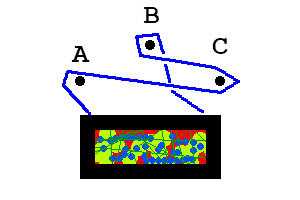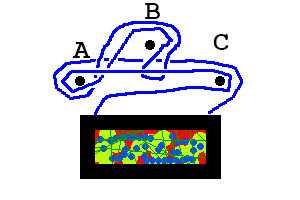42
3
Intro
There are 3 nails in the wall. You've got a piece of string that is fixed to the picture frame with both ends. To hang the picture, you entangled the string with the nails. But before letting the picture go: Can you predict whether the image is going to fall, just by looking at how the string is wrapped around the nails?


In the first example the picture will not fall. In the second example the picture is going to fall.
Challenge
Given the path of the string around N nails, determine whether the picture is going to fall or not. Return a truthy value if the picture is going to fall, and a falsy value otherwise.
Details
- You can assume that the nails and the picture are arranged in a regular
N+1-gon, with the picture at the bottom. - You can assume that there are no knots in the rope, i.e. the rope can be continuously be uwrapped from one of the two ends.
- Each nail is enumerated clockwise with a letter of the alphabet. You can assume that there are at most 26 nails (A-Z).
- A clockwise wrap around a nail is denoted with the lower case letter, a counter clockwise wrap is denoted with an upper case letter.
The first example from above will be encoded as BcA, the second example is encoded as CAbBac.
For the inclined reader: This problem is equivalent to determining whether an element of the free group - generated by the set of nails - is the identity or not. This means it is sufficient to repeatedly cancel substrings like aA or Aa until you reached a fixed point. If the fixed point is an empty string, this is the neutral element, otherwise it is not.
Examples
Picture will fall:
Aa
CAbBac
aBbA
DAacAaCdCaAcBCBbcaAb
ARrQqRrUuVHhvTtYyDdYyEKRrkeUWwua
AKkQqEeVvBESWwseYQqyXBbxVvPpWwTtKkVHLlWwNBbAanYYyyhWwEJZUuNnzjYyBLQqQqlEGgebeEPLlTtZzpUuevZzSsbXSGgsUuLlHhUQquPpHUuFfhTZzIitGgFAaBRrBbbYXxOoDZTDdtzVvXxUudHhOVvoUuXKkxyBEeLlbFfKkHhfVAaQqHAaJjODdoVvhSsZzMZzmPpXNBbnxBbUuSSsUuDRrdNnUusJDIiUuIidCEGgeMmcLlDPOopdTEeQqCAETtNnYyeGUuPEFfSsWwHheAaBbpgCcOHUuhAaCcoEFBbfeaFHhfcCFFffNncGFfgtjMVUuKAakvKkXxLlTMmtmOFfoUuXSsYZzLXxlyxUuRPZzTtprSsWwRrPLlpGgMmKRrDHhdRCcUurYNnKCckykXJjxWwUSsJjKkLlKkuBbBbOoWwWwIiUuPDdBbCcWHBbCFfcDdYBbLlyVvSsWGgEewCchDdYywAaJjEepPpPpQXxZzFfLGXxglNnZzYDdyqCcKWXxwXxQqXTtxkFfBSSAasTFftZzsXGgxSsLlLlbZzAaCCccXVvYyxTIiOoBbFftCVQqDdBbGgAavQqKkDPpKTCctRrkdcvAaQWOowLOolqVMmvZAaHCBbcPphIiRKkrLlzFMOomDIiXJjIixMmdNnMHhmfNTtIiKkSDdTtsVvHhnAaNSVvTUutNnXxsGIiXxPpPHhUupgNnAaAAOoaaIiHJjhVvLlnYyXxQqSsTtKJjkBbNnVvEYCcFfMHGghBbmNnEeJTtjJjWYywyeNWwDIiZYyzOodnMQqmVvCcQqxVvGNnEeNBbngVvUGgYyBbDdVvIiAAaauPpQKDdEekNnVLlvHhGSDIidPZzpsPCcpgQqKkQqNOonLlIiLlJjqPAaPXxTtppYyCPpHhCIicARBbracXxWwXEVUuUuGgZHhzBSsbvGgFfeVvxLlNKknWwBLlIibWOowNnRSsrSEeKAakOosLZzZRrHhzTtTFfUuNnOKkotXxTtla
Picture will not fall:
A
BcA
ABCD
aBaA
bAaBcbBCBcAaCdCaAcaCAD
ARrQqRrUatuVHhvTYyDdYyEKRrkeUAua
AEEeQqNneHhLlAIiGgaECXxcJjZzeJFfVWwDdKkvYWwyTJjtCXxANIinaXWwxcTWwtUuWwMmTBbVWIiFLlWwZzfwPLlEepvWZzwKkEYEeWXxwySXTtEexRIiNBbnWAaTtQqNnBMSsWwOombwWwPVPpGPpgYyvDdpBbrQqHhUusKRrDAVvadLlWwOZzokGJCXSSssXxxJPpGIigZzjJjLlOoNRrnPpcMZzmjgJjNDEeQqWKkNTtnSswIidCcnYBGgbyJSsjPpIiMmMmMmSNnWVvwZzIQqLXHhxTPptlisOoeTtTtYMmVvPpyKNnMFfmkXxSVvsCGJjXxgXYJPpjWwQIiXxqyDdxFfDdAaRNnJjrctHBbZzhEQqMmeCcRBbrGgAaAaJNnRrYyWwSDdVvsJOojQGgWWwIBbiwRrqJjjWwOoFPMmDdRrQOoqNnRrDPJjpMmdPpGFfVvWUuwgpWCcNnPpwfUXCcZzJjUSsuXxxUuuRGgHhrSQqJjOosMMTtmHhmKkXxDdLlWwjSUuAaMmKYyksZzVvPZzVEeVvvHhZZOozBbzMmZCczYyGgISsiQqpXxMmXxEMmeRrAGgaGgMOGgomZFfDdzSSssBGPpgbTtBbOoRWWwGgLJjlEeGgLDdRrUulNnZzJjJjUKkuXxFfwATtaZzLVvlWwSsMmrBAaELleGBLFflbgHhbIFfiBbPpTWZzwKkKLASsaTJYyjtBbBbWwIiZCcWwzIiZLlUTtuBbYyBbIizTJjtLTtDOOoBbodBbllSsUGgLlAKkauYykUuUNnPpuDFfAaLNVvnVvlHhdMmBAaBbIiVRrGWOoPpwgWXwKkvJjOoTtYCUucVGgYyLlVvFfvRrMmySsDdbtICZzcNnINSOosDQAaXoxRGgKkrqdZznDdXxZzMGgmiJjNnACcMQqmaNnWZzUOuwTVvAJjSsaRrGgSsTtOMmRroVvRrtAVGgvMmaINniDGCcOogRrWwMVvYFfyTtmTtVvOoOIiodRrGgAxaSsGgiJja
3It seems that in freeing one's hands to write down the string's path, the picture would fall anyway. Then this challenge becomes really easy. – owacoder – 2017-01-13T22:15:32.260
@owacoder You just have to be quick enough :D – flawr – 2017-01-13T22:22:25.757
Relevant: https://www.youtube.com/watch?v=x5h3yTxeCew
– flawr – 2019-08-02T19:36:14.837